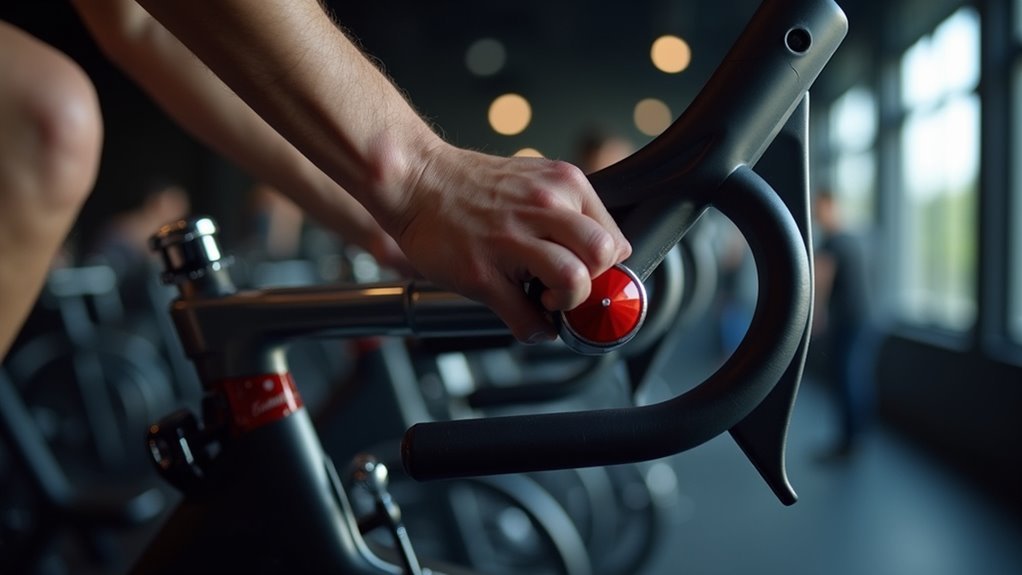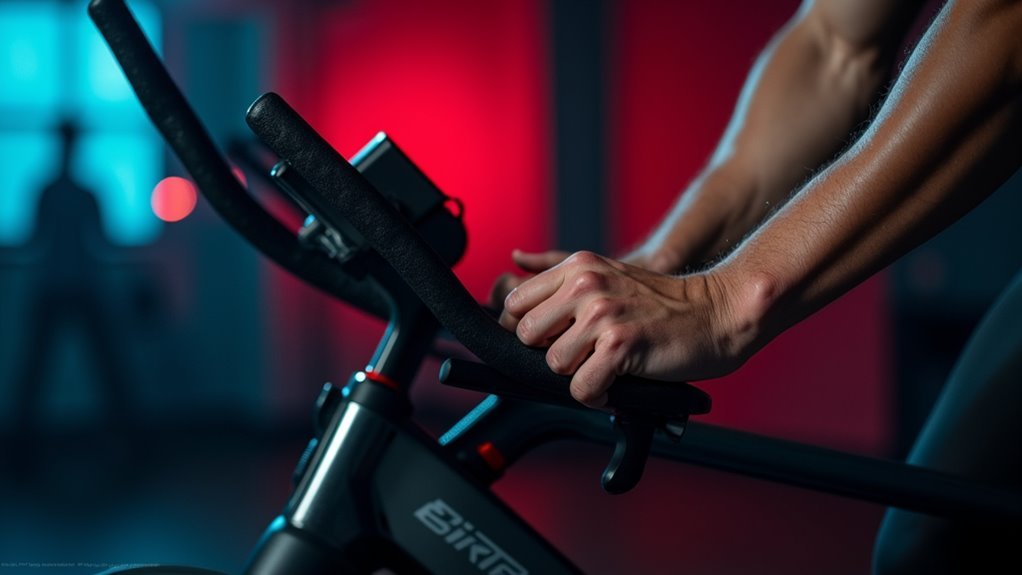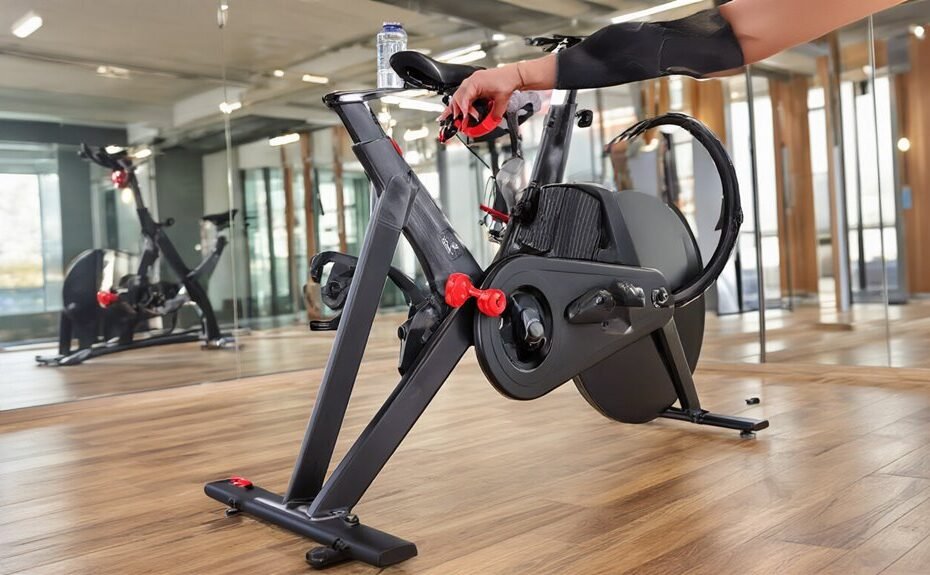Perfecting a spin bike’s resistance isn’t just about turning a knob. It’s about finding that sweet spot where the workout challenges without overwhelming. Many riders struggle with this balance, often using settings that are too light or impossibly heavy. The difference between proper and improper resistance can mean the difference between results and injury. Well, it’s actually—it’s more like finding the right gear on a hill climb. What exactly makes resistance “perfect” though? The answer varies for everyone.
Understanding Your Spin Bike’s Resistance Mechanism
Every spin bike enthusiast should begin their fitness journey by understanding the heart of their equipment: the resistance mechanism.
Spin bikes typically feature one of two systems: friction resistance, which uses brake pads against the flywheel, or magnetic resistance, which employs magnets for a quieter, smoother ride with less maintenance.
Knowing how to properly adjust the resistance on exercise bikes is vital for effective workouts.
Most spin bikes have a dial or electronic controls that allow riders to increase or decrease resistance levels to match their fitness goals.
This calibration isn’t just about intensity—it’s about safety and getting the most from your cycling sessions. Additionally, technology and connectivity options can enhance your training experience and provide valuable feedback on your performance.
Gradual Resistance Adjustments for Optimal Performance
When riders find the perfect balance in their resistance settings, spin bike workouts transform from simple exercises to dynamic, engaging sessions.
Experienced riders know that gradual resistance adjustments are key to maintain proper form and prevent muscle strain.
Starting with lower settings (1-4) during warm-ups allows the body to adapt before tackling more intense intervals.
As you adjust resistance, aim for 60 RPM on hills and 80-100 RPM for flatter simulations.
Listen to your body—if pedaling becomes too challenging, don’t hesitate to dial back.
These thoughtful modifications not only enhance your cardiovascular health but make indoor cycling both effective and sustainable. Incorporating magnetic resistance into your setup can further improve the smoothness and precision of your workouts.
Troubleshooting Common Resistance Issues

Despite owning a top-quality spin bike, riders often encounter resistance problems that can derail their workout momentum.
When adjusting the resistance becomes difficult, first check for loose cables—they’re often the culprits. The resistance knob might need lubrication if it feels sticky during use.
For consistent performance on your stationary bike, regularly calibrate your bike according to manufacturer specifications. This is especially important with friction-based systems that naturally wear down over time.
If issues persist, don’t struggle needlessly—consult your owner’s manual for model-specific guidance or reach out to technical support. They’ve probably seen your exact problem dozens of times before! Additionally, regular maintenance like checking alignment ensures optimal bike performance and reduces wear.
Calibrating Your Bike for Consistent Resistance Levels
Consistent performance on your spin bike starts with proper calibration, a critical yet often overlooked maintenance step that guarantees your resistance levels remain accurate over time.
Proper calibration guarantees your workouts stay effective and measurable.
- Follow manufacturer guidelines – Each spin bike model has specific calibration instructions that should be performed regularly.
- Check resistance cables – Look for loose connections that might affect how well you can adjust resistance.
- Test through full range – Verify the resistance knob works properly by pedaling through all settings.
- Monitor perceived effort – Your body is the best gauge; resistance should feel appropriate for your workout goals. Additionally, understanding drag forces in cycling can further enhance your workout effectiveness by allowing you to adjust your effort based on perceived exertion.
Customizing Resistance Settings for Different Workout Goals

Once your bike is properly calibrated, applying the right resistance settings becomes the key to achieving your specific fitness objectives. On spinning bikes, resistance levels should align with specific goals and personal fitness levels. For endurance, keep settings between 1-4 to maintain a brisk cadence without excessive fatigue. During interval training, alternating between high and low resistance guarantees your core is engaged while optimizing both strength and recovery. Regular cycling improves cardiovascular fitness, which is crucial for effective weight loss and overall health.
| Workout Type | Resistance Level | Target RPM |
|---|---|---|
| Endurance | 1-4 | 80-100 |
| HIIT | Varied (1-8) | 60-100 |
| Strength | 5-8+ | ~60 |
| Speed | 1-5 | 80-100 |
| Recovery | 1-3 | 70-90 |
Remember to adjust resistance based on how your body responds – that’s the real measure of an effective bike workout.
Frequently Asked Questions
How to Increase Resistance on a Spin Bike?
Like taming a wild stallion, cyclists increase resistance by turning the knob clockwise. Adjusting tension enhances workout intensity during spin classes, improving pedal power, endurance training benefits, and elevating heart rate through resistance settings.
Is It Better to Cycle Faster or With More Resistance?
Neither is universally better. Speed benefits cardiovascular endurance while resistance advantages include greater muscle engagement. Ideal workout intensity depends on fitness goals—combining both maximizes calorie burn and supports thorough endurance training.
Is 20 Minutes a Day on a Stationary Bike Enough?
While couch potatoes scoff, twenty minutes daily on a stationary bike offers real benefits: efficient calorie burn, muscle engagement, heart health improvements—adequate for maintenance with proper workout intensity and mental focus.
How to Determine Resistance on Spin Bike?
Determining resistance on a spin bike involves understanding resistance settings relative to effort level, monitoring cadence, and adjusting resistance based on pedal stroke feel. This personalized spin bike tension supports specific fitness goals while preventing injury.
